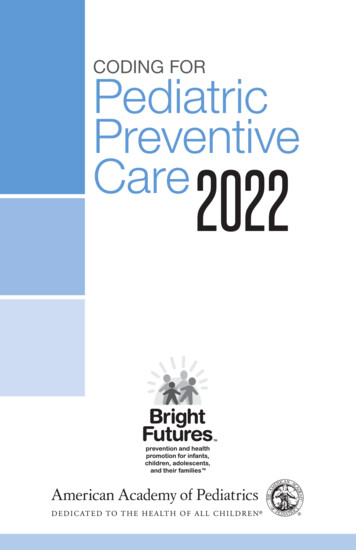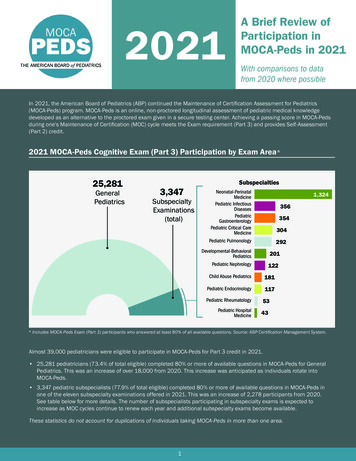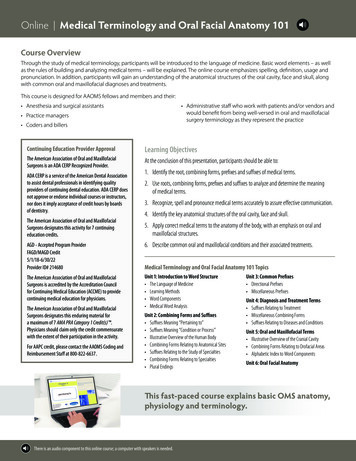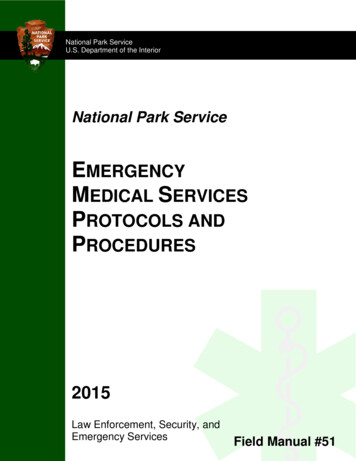
Transcription
CODING FORPediatricPreventiveCare2022TM
Coding for Pediatric Preventive Care, 2022This resource contains comprehensive listings of codes that may notbe used by your practice on a regular basis. We recommend that youidentify the codes most relevant to your practice and include those onyour encounter form or billing sheet.Following are the Current Procedural Terminology (CPT ), HealthcareCommon Procedure Coding System (HCPCS) Level II, and InternationalClassification of Diseases, 10th Revision, Clinical Modification (ICD-10-CM)codes most commonly reported by pediatricians in providing preventivecare services. The pediatrician, not the staff, is ultimately responsible forthe appropriate codes to report.SYMBOL DESCRIPTION A bullet at the beginning of a code means it is a new code for the current year. A plus sign means the code is an add-on code. A lightning bolt indicates that a vaccine product code was approved, but thevaccine product is still pending FDA approval.The recommendations in this publication do not indicate an exclusive course of treatment orserve as a standard of medical care. Variations, taking into account individual circumstances,may be appropriate. 2022 American Academy of PediatricsAll rights reserved. No part of this publication may be reproduced, stored in a retrieval system, ortransmitted in any form or by any means—electronic, mechanical, photocopying, recording, orotherwise—without prior written permission from the publisher.Printed in the United States of AmericaCurrent Procedural Terminology (CPT ) 5-digit codes, nomenclature, and other data are copyright2021 American Medical Association (AMA). All rights reserved. No fee schedules, basic units,relative values, or related listings are included in CPT. The AMA assumes no liability for thedata contained herein.The Bright Futures/American Academy of Pediatrics “Recommendations for Preventive PediatricHealth Care,” also known as the “periodicity schedule,” is a schedule of screenings and assessmentsrecommended at each well-child visit from infancy through adolescence. The following servicesand codes coincide with this schedule. For more details on the periodicity schedule, -delivery-approaches/periodicity-schedule/.1
PREVENTIVE MEDICINE SERVICE CODESServices included under these codes include measurements (eg, length/height, head circumference, weight, body mass index, blood pressure)and age- and gender-appropriate examination and history (initial orinterval). Preventive medicine service codes are not time-based; therefore, timespent during the visit is not relevant in selecting the appropriatepreventive medicine service code. If an illness or abnormality is discovered, or a preexisting problemis addressed, in the process of performing the preventive medicineservice, and if the illness, abnormality, or problem is significantenough to require additional work to perform the componentsof a problem-oriented evaluation and management (E/M) service(ie, using medical decision making or time spent), the appropriateoffice or other outpatient service code (99202–99215) should bereported in addition to the preventive medicine service code.Append modifier 25 to the office or other outpatient servicecode (eg, 99392 and 99213 25). An insignificant or trivial illness, abnormality, or problem encounteredin the process of performing the preventive medicine service shouldnot be separately reported. The comprehensive nature of the preventive medicine servicecodes reflects an age- and gender-appropriate history and physicalexamination and is not synonymous with the comprehensiveexamination required for some other E/M codes (eg, 99204,99205, 99215). Immunization products and administration and ancillary studiesinvolving laboratory, radiology, or other procedures, or screeningtests (eg, vision, developmental, hearing) identified with a specificCPT code, are reported and paid for separately from the preventivemedicine service code. For more information on coding during the COVID-19 pandemic(including telemedicine and telehealth), refer to the AAP's codingsite (www.aap.org/coding) and its page dedicated to this coding.2
Preventive Medicine Services: New Patients Initial comprehensive preventive medicine E/M of an individualincludes an age- and gender-appropriate history; physical examination;counseling, anticipatory guidance, or risk factor reduction interventions; and the ordering of laboratory or diagnostic procedures. A new patient is defined as one who has not received any professionalface-to-face services rendered by physicians and other qualified healthcare professionals (QHPs) who may report E/M services and reportedby a specific CPT code(s) from a physician/other QHP, or anotherphysician/other QHP of the exact same specialty and subspecialtywho belongs to the same group practice, within the past 3 years.CPT CodesICD-10-CM Codes99381Z00.110 Health supervision for newbornunder 8 days old orInfant (younger than 1 year)Z00.111 Health supervision for newborn8 to 28 days old orZ00.121 Routine child health examwith abnormal findings orZ00.129 Routine child health examwithout abnormal findings99382Early childhood (age 1–4 years) Z00.12199383Late childhood (age 5–11 years) Z00.12999384Adolescent (age 12–17 years)9938518 years or olderZ00.00General adult medical examwithout abnormal findingsZ00.01General adult medical examwith abnormal findings3
Preventive Medicine Services: Established PatientsPeriodic comprehensive preventive medicine reevaluation and management of an individual includes an age- and gender-appropriate history;physical examination; counseling, anticipatory guidance, or risk factorreduction interventions; and the ordering of laboratory or diagnosticprocedures.CPT CodesICD-10-CM Codes99391 Infant (younger than 1 year)Z00.110 Health supervision for newbornunder 8 days old orZ00.111 Health supervision for newborn8 to 28 days old orZ00.121 Routine child health examwith abnormal findings orZ00.129 Routine child health examwithout abnormal findings99392 Early childhood (age 1–4 years)Z00.12199393 Late childhood (age 5–11 years)Z00.12999394 Adolescent (age 12–17 years)99395 18 years or olderZ00.00General adult medical examwithout abnormal findingsZ00.01General adult medical examwith abnormal findingsPreventive Medicine Services: With And Without Abnormal FindingsThe use of an ICD-10-CM code for with abnormal findings (eg, Z00.121)does not mean that an additional E/M service must or can be used.Abnormal findings can be trivial or incidental issues that do not requireadditional work, but the condition is still documented or listed as contributory. Examples of abnormal findings include abnormal screeningresults, new acute problem, or unstable or worsening chronic condition.A stable chronic condition (whether addressed or not) would not warrantthe use of an abnormal findings code. You can link an abnormal findingsICD-10-CM code to a screening if the screen is normal; the abnormalitywill be identified with the appropriate ICD-10-CM code so the payer willbe aware.4
COUNSELING, RISK FACTOR REDUCTION, ANDBEHAVIOR CHANGE INTERVENTION CODESUsed to report services provided for the purpose of promoting healthand preventing illness or injury. They are distinct from other E/M services that may be reportedseparately when performed. However, one exception is you cannotreport counseling codes (99401–99404) in addition to preventivemedicine service codes (99381–99385 and 99391–99395). Counseling will vary with age and address such issues as familydynamics, diet and exercise, sexual practices, injury prevention,dental health, and diagnostic or laboratory test results availableat the time of the encounter. Codes are time-based, where the appropriate code is selectedaccording to the approximate time spent providing the service.Codes may be reported when the midpoint for that time haspassed. For example, once 8 minutes are documented, one mayreport 99401. Extent of counseling or risk factor reduction intervention mustbe documented in the patient chart to qualify the service basedon time. Counseling or interventions are used for persons without a specificillness for which the counseling might otherwise be used as part oftreatment. Cannot be reported with patients who have symptoms or establishedillness. For counseling individual patients with symptoms or establishedillness, report an office or other outpatient service code (99202–99215) instead. For counseling groups of patients with symptoms or establishedillness, report 99078 (physician educational services rendered topatients in a group setting) instead.5
Preventive Medicine, CounselingCPT Codes99401Preventive medicine counseling or risk factor reductionintervention(s) provided to an individual; approximately15 minutes99402approximately 30 minutes99403approximately 45 minutes99404approximately 60 minutes9941199412Preventive medicine counseling or risk factor reductionintervention(s) provided to individuals in a group setting;approximately 30 minutesapproximately 60 minutesICD-10-CM Codes for Preventive Counseling The diagnosis codes reported for preventive counseling will varydepending on the reason for the encounter. Remember that the patient cannot have symptoms or establishedillness; therefore, the diagnosis codes reported cannot reflectsymptoms or illnesses. Examples of some possible diagnosis codes includeZ28.3Underimmunized status (Code also reason patient is behind,eg, Z28.82 [caregiver refusal])Z71.3Dietary surveillance and counselingZ71.82Exercise counselingZ71.84Encounter for health counseling related to travelZ71.85Encounter for immunization safety counseling (Code also ifvaccine is not carried out [eg, Z28.82])Z71.89Other specified counselingZ71.9Counseling, unspecifiedBehavior Change Interventions, Individual Used only when counseling a patient (not parent) on smokingcessation (99406, 99407). If counseling a patient’s parent or guardian on smoking cessation, donot report these codes (99406, 99407) under the patient; instead, refer6
to preventive medicine counseling codes (99401–99404) if the patientis not currently experiencing adverse effects (eg, illness), or includeunder the problem-related E/M service if patient is present for asick visit (99202–99215). Codes 99406–99409 may be reported in addition to the preventivemedicine service codes.CPT Codes99406Smoking and tobacco use cessation counseling visit;intermediate, greater than 3 minutes up to 10 minutes994079940899409intensive, greater than 10 minutesAlcohol or substance (other than tobacco) abuse structuredscreening (eg, Alcohol Use Disorder Identification Test[AUDIT], Drug Abuse Screening Test [DAST]) and briefintervention (SBI) services; 15 to 30 minutesgreater than 30 minutesICD-10-CM Codes for Risk Factor Reduction and Behavior ChangeInterventionsF10.10Alcohol abuse, uncomplicatedF11.10Opioid abuse, uncomplicatedF12.10Cannabis abuse, uncomplicatedF13.10Sedative, hypnotic or anxiolytic abuse, uncomplicatedF13.90Sedative, hypnotic, or anxiolytic use, unspecified, uncomplicatedF15.90Other stimulant use, unspecified, uncomplicatedF16.90Hallucinogen use, unspecified, uncomplicatedF17.290Nicotine dependence, other tobacco products (IncludesElectronic nicotine delivery systems [ENDS]/vaping products)Z71.41Alcohol abuse counseling and surveillance of alcoholicZ71.51Drug abuse counseling and surveillance of drug abuserZ71.6Tobacco abuse counselingZ87.891 Personal history of nicotine dependenceZ91.89Other specified personal risk factors, presenting as hazards tohealth not elsewhere classified7
OTHER PREVENTIVE MEDICINE SERVICESOral HealthCPT Code99188Application of topical fluoride varnish by a physician or otherqualified health care professionalRefer to page 15 for the definition of QHP.ICD-10-CM CodesZ00.121 Routine child health exam with abnormal findingsZ00.129Routine child health exam without abnormal findingsZ29.3Encounter for prophylactic fluoride administrationZ91.841 Risk for dental caries, lowZ91.842 Risk for dental caries, moderateZ91.843 Risk for dental caries, highZ91.849 Unspecified risk for dental cariesPelvic Examination Preventive medicine service codes (99381–99385 and 99391–99395)include a pelvic examination as part of the age- and gender-appropriateexamination. If the patient is having a problem, the physician can report an officeor other outpatient E/M service code (99212–99215) for the visit andattach modifier 25, which identifies that the problem-oriented pelvicvisit is a separately identifiable E/M service by the same physician onthe same date of service. Link the appropriate ICD-10-CM code for the well-child or well-adultexamination with abnormal findings (Z00.121 or Z00.01) to thepreventive medicine service code, but link a different diagnosis code(eg, N89.8 [vaginal discharge], N94.4 [primary dysmenorrhea]) tothe office or other outpatient E/M service code (eg, 99212). Anticipatory or periodic contraceptive management is not a “problem”and is therefore included in the preventive medicine service code;however, if contraception creates a problem (eg, breakthroughbleeding, vomiting), the service can be reported separately withan office or other outpatient service code.8
ICD-10-CM CodesZ01.411 Gynecological exam with abnormal findingsZ01.419Gynecological exam without abnormal findingsZ11.51Screening for human papillomavirus (HPV)Z12.72Screening for malignant neoplasm of vaginaZ30.011 Initial prescription of contraceptive pillsZ30.012 Prescription of emergency contraceptionZ30.013 Initial prescription of injectable contraceptiveZ30.014 Initial prescription of intrauterine contraceptive device (IUD)Z30.015 Encounter for initial prescription of vaginal ring hormonalcontraceptiveZ30.016 Encounter for initial prescription of transdermal patchhormonal contraceptive deviceZ30.017 Encounter for initial prescription of implantable subdermalcontraceptiveZ30.018 Encounter for initial prescription of other contraceptivesZ30.02Counseling and instruction in natural family planning toavoid pregnancyZ30.09General counseling and advice on contraceptionZ30.40Surveillance of contraceptives, unspecifiedZ30.41Surveillance of contraceptive pillsZ30.42Surveillance of injectable contraceptiveZ30.430 Insertion of IUDZ30.431 Routine checking of IUDZ30.432 Removal of IUDZ30.433 Removal and reinsertion of IUDZ30.44Encounter for surveillance of vaginal ring hormonalcontraceptive deviceZ30.45Encounter for surveillance of transdermal patch hormonalcontraceptive deviceZ30.46Encounter for surveillance of implantable subdermalcontraceptiveZ30.49Surveillance of other contraceptives9
Health Risk AssessmentsCPT Codes96160Administration of patient-focused health risk assessmentinstrument (eg, health hazard appraisal) with scoring anddocumentation, per standardized instrument96161Administration of caregiver-focused health risk assessment instrument (eg, depression inventory) for the benefit of the patient,with scoring and documentation, per standardized instrumentNOTE: Code 96161 can be reported for a postpartum screening administeredto a mother as part of a routine newborn check but billed under the baby’sname. Link to ICD-10-CM code Z00.121 or Z00.129 for normal screeningresults during a routine well-baby examination. Do not report ICD-10-CMcode Z13.31 or Z13.32 under the baby, as those are only for the maternalrecord. Alternatively, payers may require G0442 (Annual alcohol misusescreening, 15 minutes) in lieu of 96160 if screening for alcohol use. Used to report administration of standardized health risk assessment instruments on the patient (96160) or a primary caregiver (eg, parent) on behalf ofthe patient (96161). Code 96160 would be used to report a standardizedsuicide risk assessment linked to ICD-10-CM code Z13.39 (Encounter forscreening examination for other mental health and behavioral disorders).Code 96161 requires that the questions and answers relate to the primarycaregiver’s health and behaviors, not the patient’s. For standardized questionnaires about the family's environment (that includes the patient), reportcode 96160. CPT defines standardization as, “Standardized instruments are validated teststhat are administered and scored in a consistent or ‘standard’ mannerconsistent with their validation.” A non-standardized screen or assessment is not separately reported, unless aspecific payer allows. At the time of publication, the recommended Sudden Cardiac Arrest/Deathrisk assessment was not standardized, therefore no separate CPT code can bereported.Unlisted Preventive Medicine ServiceCPT Code99429Unlisted preventive medicine serviceReport code 99429 only when a more specific preventive medicine servicecode does not exist.10
SCREENING CODESDevelopmental/Autism Screening and Behavioral/Social/Emotional ScreeningCPT CodesICD-10-CM Codes96110 Developmental screening,per instrument, scoringand documentationZ13.41 Encounter for autism screening96127 Brief emotional/behavioralassessment (eg, depressioninventory) with scoringand documentation, perstandardized instrumentZ13.31 Encounter for screening fordepressionZ13.42 Encounter for screening for globaldevelopmental delays (milestones)Z13.39 Encounter for screening examinationfor other mental health andbehavioral disorders Used to report administration of standardized developmental/autismscreening instruments (96110) or behavioral/social/emotional screeninginstruments (96127). See page 10 for the definition of standardized. Often reported when performed in the context of preventive medicineservices but may also be reported when screening or assessment isperformed with other E/M services (eg, acute illness or follow-upofficevisits). Clinical staff (eg, registered nurse) typically administers and scores thecompleted instrument, while the physician incorporates theinterpretation component into the accompanying E/M service. When a standardized screening or assessment is administered along withany E/M service (eg, preventive medicine service), both services shouldbe reported, and modifier 25 (significant, separately identifiable E/Mservice by the same physician on the same day of the procedure or otherservice) may need to be appended to the E/M code to show the E/Mservice was distinct and necessary at the same visit. Alternatively, some payers may require the use of code G0444 (annualdepression screening, 15 minutes) in lieu of code 96127 for the routinedepression screening. For more information on reporting 96110 and 96127 instruments, refer tohttps://downloads.aap.org/AAP/PDF/coding Behvioraassessment.pdf.11
Hearing ScreeningCPT CodesICD-10-CM Codes92551 Screening test, pure tone,air onlyZ00.121 Routine child health examwith abnormal findings92552 Pure tone audiometry(threshold), air onlyZ00.129 Routine child health examwithout abnormal findings92567 Tympanometry(impedance testing) Requires use of calibrated electronic equipment; tests using othermethods (eg, whispered voice, tuning fork) are not reported separately. Includes testing of both ears; append modifier 52 when a test is appliedto only one ear. For newborn hearing screenings for young patients, including thosepatients who are nonverbal or have developmental delays, other hearingassessment methods may be more appropriate.CPT CodesICD-10-CM Codes92558 Evoked otoacoustic emissions,screening (qualitative measurementof distortion product or transientevoked otoacoustic emissions),automated analysisZ00.110 Health supervision fornewborn under 8 days oldor92650 Auditory evoked potentials;screening of auditory potential withbroadband stimuli, automatedanalysisZ00.111 Health supervision fornewborn 8 to 28 days oldorZ00.121 Routine child health examwith abnormal findingsZ00.129 Routine child health examwithout abnormal findingsP09.692587 Distortion product evokedotoacoustic emissions; limitedevaluation (to confirm the presenceor absence of hearing disorder, 3-6frequencies) or transient evokedotoacoustic emissions, withinterpretation and report92588comprehensive diagnosticevaluation, with interpretationand report12Abnormal findings onneonatal screening
Codes Z01.10 (encounter for examination of ears and hearing withoutabnormal findings) and Z01.118 (encounter for examination of earsandhearing with other abnormal findings) are reported only when a patientpresents for an encounter specific to ears and hearing, not for a routinewell-child examination at which a hearing screening is performed. Failed hearing screenings will most likely result in a follow-up officevisit (eg, 99212–99215). Code Z01.110 (encounter for hearing examination following failed hearing screening) is reported when a specificdisorder cannot be identified or when the follow-up hearing screeningfindings are normal. You can also report Z01.118 (encounter for examination of ears and hearing with other abnormal findings) and includethe code for the abnormal findings (eg, R94.120 [abnormal auditoryfunction study]).Vision ScreeningCPT CodesICD-10-CM Codes99173 Screening test of visual acuityquantitative, bilateralZ01.020 Encounter for examination of eyesand vision following failed visionscreening without abnormalfindingsZ01.021 Encounter for examination of eyesand vision following failed visionscreening with abnormal findingsZ00.121 Routine child health examwith abnormal findings99174 Instrument-based ocularZ00.129 Routine child health examscreening (eg, photoscreening,without abnormal findingsautomated-refraction), bilateral,with remote-analysis and report99177 Instrument-based ocularscreening (eg, photoscreening,automated-refraction), bilateral,with on-site analysisZ01.00 and Z01.01 (examination of eyes and vision with and withoutabnormal findings) are reported only for routine examination of eyes andvision, not when a vision screening is done during a routine well-childexamination.13
To report code 99173, you must employ graduate visual acuity stimulithat allow a quantitative estimate of visual acuity (eg, Snellen chart). Codes 99174 and 99177 are reported for instrument-based ocularscreening for esotropia, exotropia, anisometropia, cataracts, ptosis,hyperopia, and myopia. Code 99177 is reported in lieu of 99174 when the screening instrumentprovides you with immediate pass or fail results. When acuity (99173) or instrument-based ocular screening (eg, 99174)is measured as part of a general ophthalmologic service or an E/Mservice of the eye (eg, for an eye-related problem or symptom), itis considered part of the diagnostic examination of the office orother outpatient service code (99202–99215) and is not reportedseparately. Other identifiable services unrelated to the screening test providedat the same time are reported separately (eg, preventive medicineservices). Failed vision screenings will most likely result in a follow-up officevisit (eg, 99212–99215). Report the follow-up screening withZ01.020 (encounter for examination of eyes and vision followingfailed vision screening without abnormal findings) if normal resultsor Z01.021 (encounter for examination of eyes and vision followingfailed vision screening with abnormal findings) if abnormal results.If abnormal, link to the diagnosis code for the reason for the failure(eg, H52.1- [myopia]); when a specific disorder cannot be identified,report R94.118 (abnormal results of other function studies of eye).14
IMMUNIZATIONSImmunization Administration (IA)Pediatric IA Codes90460Immunization administration (IA) through 18 years of agevia any route of administration, with counseling by physicianor other qualified health care professional; first or onlycomponent of each vaccine or toxoid administered 90461each additional vaccine or toxoid componentadministered (List separately in addition to code forprimary procedure.)Report 90461 in conjunction with 90460. Component refers to all antigens in a vaccine that prevent diseasescaused by 1 organism. Multivalent antigens or multiple serotypes ofantigens against a single organism are considered a single componentof vaccines. Combination vaccines are vaccines that contain multiplevaccine components. Conjugates or adjuvants contained in vaccinesare not considered to be component parts of the vaccine, as definedpreviously. A QHP is an individual who by education, training, licensure/regulation, facility credentialing (when applicable), and payer policyis able to perform a professional service within his or her scope ofpractice and to independently report a professional service. Theseprofessionals are distinct from clinical staff. A clinical staff memberis a person who works under the supervision of a physician or otherQHP and who is allowed by law, regulation, facility, and payer policyto perform or assist in the performance of specified professionalservices but does not individually report any professional services. Code 90460 is used to report the first or only component in a singlevaccine given during an encounter. You can report 90460 more thanonce during a single office encounter. Code 90461 is considered anadd-on code to 90460 (hence the symbol next to it). This meansthat the provider will use 90461 in addition to 90460 if more than1 component is contained within a single vaccine administered.CPT codes 90460 and 90461 are reported regardless of route ofadministration.15
Pediatric IA codes (90460, 90461) are reported only when both of thefollowing requirements are met:1. The patient must be 18 years or younger.2. The physician or other QHP must perform face-to-face vaccinecounseling associated with the administration.NOTE: The clinical staff can do the actual administration of the vaccine. If both of these requirements are not met, report a non–age-specificIA code (90471–90474) instead.Non–age-specific IA Codes Report a CPT code for both the administration and product and anICD-10-CM code for each vaccine administered during a patientencounter.90471IA (includes percutaneous, intradermal, subcutaneous, orintramuscular injections); one vaccine (single or combinationvaccine/toxoid)Do not report 90471 in conjunction with 90473. 90472each additional vaccine (single or combination vaccine/toxoid) (List separately to code for primary procedure.)Use 90472 in conjunction with 90460, 90471, or 90473.90473IA (includes intranasal or oral administration); one vaccine(single or combination vaccine/toxoid)Do not report 90473 in conjunction with 90471. 90474each additional vaccine (single or combination vaccine/toxoid) (List separately to code for primary procedure.)Use 90474 in conjunction with 90460, 90471, or 90473. Codes 90471 and 90473 are used to code for the first immunizationgiven during a single office visit. Codes 90472 and 90474 are considered add-on codes (hence the symbol next to them) to 90460,90471, and 90473. This means that the provider will use 90472 or90474 in addition to 90460, 90471, or 90473 if more than 1 vaccineis administered during a visit. There can be only 1 first administrationduring a given visit. (See vignettes 3, 4, and 5 on pages 21–23.)16
If during a single encounter for a patient 18 years or younger, a physician or other QHP only counsels on some of the vaccines, report code90460 (and 90461 when applicable) for those counseled on and deferto codes 90472 or 90474, as appropriate, for those that are notcounseled on. The following vignettes may help illustrate the correct use of theadministration codes (see pages 25–28 for a full list of vaccineproduct codes):NOTE: The coding vignettes are for teaching purposes only and do notnecessarily follow every payer’s reporting requirements.Vignette 1A 2-month-old established patient presents for her checkup. The following vaccines are ordered: Pentacel (diphtheria-tetanus-acellular pertussis[DTaP], Haemophilus influenzae type b [Hib], inactivated poliovirus[IPV]), pneumococcal, and rotavirus. The physician counsels the parentson all of them, consent is obtained and the nurse administers them all.How are the appropriate codes for this service selected?Step 1: Select appropriate E/M code.Preventive medicine service, established patient, infant99391(age younger than 1 year)Step 2: Select appropriate vaccine product codes.90698DTaP-Hib-IPV (Pentacel) product90670Pneumococcal product90680Rotavirus vaccine, oral useStep 3: Select appropriate IA codes by considering the following questions: Is the patient 18 years or younger? If the patient is younger than 18 years, did the physician or other QHPperform the face-to-face vaccine counseling, discussing the specificrisks and benefits of the vaccines?If the answer to both questions is yes, select a code from the pediatric IAcode family (90460, 90461). If the answer to one of the questions is no,select a code from the non–age-specific IA code family (90471–90474).In this vignette, the answer to both questions is yes. Therefore, IA codes90460 and 90461 will be reported.17
Step 4: Select the appropriate ICD-10-CM diagnosis codes.Diagnosis codes are used along with CPT codes to reflect the outcomeof a visit. The CPT codes tell a carrier what was done, and ICD-10-CMcodes tell a carrier why it was done.The vaccine product CPT code and its corresponding IA CPT code arealways linked to the same ICD-10-CM code. This is because the vaccineproduct and work that goes into administering that product are intendedto provide prophylactic vaccination against a certain type of disease.ICD-10-CM lists only a single code to describe an encounter in whicha patient receives a vaccine. The code is Z23, and it is reported at anyencounter when a vaccine is given, including routine well-child oradult examinations.The diagnosis codes for the 3 vaccines and 3 IA codes used in this vignetteare as follows:CPT Codes99391 25ICD-10-CM CodesPreventive medicine service, established patient, 1 yearZ00.12990698DTaP-Hib-IPV (Pentacel) productZ2390670Pneumococcal productZ
CPT. Code. 99188. pplication of topical fluoride varnish by a physician or other A ualified health care professionalq Refer to page 15 for the definition of QHP. ICD-10-CM. Codes. Z00.121. outine child health exam R. with abnormal findings. Z00.129. outine child health exam R. without abnormal findings.










